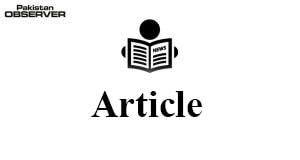Recovery from crisis to growth requires inclusivity, sustainability
WE have achieved economic growth of 3.94% in the first full financial year after the outbreak of covid-19 pandemic. The first covid-19 case in the country appeared at the end of February.
But, within four months, our GDP growth fell to a negative 0.5%. Even the target that was set for FY21 was 2.1% and the global development institutions were having their own conservative estimates between 1% and 1.5% few months back.
But, considerable growth has happened and it has come with positive changes to several economic indicators. Remittances have increased despite covid-19 to $26.7 billion during Jul-May FY21.
During the same period, exports have also climbed to $22.6 billion. Despite rise in trade deficit, current account balance has shown improvement and is currently in surplus. Reserves have slightly gone better and there is likelihood of Pakistan exiting FATF Grey list.
Large scale manufacturing sector has shown increased activity with 9% growth. Other than declining cotton production, all major crops have also seen increased production.
Nonetheless, much of the growth is contributed by large corporate sector. To be realistic, almost every economy after the covid-19’s first year was expected to post positive growth. More importantly, growth needs to be inclusive, employment creating, broad-based and sustainable.
Common man cares more about prices of essential items, cost of utilities, real wages, sustainable employment, sustainable opening of retail sector, transparency in public services and law and order. On those fronts, there are yet shortcomings.
In the recently published Economic Survey Report for 2020-21, there are some concerning points which need attention of economic policymakers.
The share of current expenditure has risen while there is decline in development expenditure as a percent of GDP.
The spending on development expenditure almost always turns out to be much less than budgeted due to the pressure on fiscal side in later months of the financial year. Interest payments alone eat up more than half of the tax revenue.
Despite lower interest rates in FY21, mark up payments as percent of GDP have risen and with increase in interest rates expected in FY22, there will be more pressure on the fiscal side.
On the fiscal front, the burden of tax on manufacturing is almost twice as much as its share in GDP while agriculture and some services are having lesser share in tax as compared to their share in GDP.
In direct taxes, there is more reliance on big corporations, salaried persons and withholding taxes.
With promised decrease in control and authority of FBR, the government is now looking to bring people into the tax net through other means, such as differential treatment in purchase of durable goods and public utility services.
There is still heavy reliance on sales tax which contributes 40% to total taxes and about 65% in total indirect taxes.
There was considerable growth in large scale manufacturing sector including automobiles, textiles and cement.
However, electronics and light engineering sector saw decline. Thus, most of the turnaround was attributed to a once-in-a-while lavish package to the construction industry. Else, the monetary side stimulants could not bring the similar fruits to the SMEs.
The share of textile in country’s exports has risen, but for the third year in sequence, cotton production is declining and we have become net importers of sugar, wheat and cotton.
Thus, there is need for easing the woes of agriculture sector with decrease in levies in inputs like seeds, pesticides, fertilizers, tractors and tube wells, for instance.
There is also need for knowledge sharing with farmers in advance to combat any pest attacks, climatic changes and the suggested remedies. Despite spending on infrastructure, there are still huge losses in supply chain.
There is need for investment in warehousing and storage facilities besides focusing on road infrastructure alone. At least in food products, we need to be self-sufficient with an ever growing population.
There is need for value addition and this requires capacity building measures. Some agriculture related imports are value added products which we should be producing through local industry.
In just about 10 months of FY21, we imported $1 billion worth of wheat and $0.5 billion worth of tea. Once in the top producing lists, we have now become net importers of sugar, wheat and cotton.
Through increased production, not only we can save foreign exchange, but create local employment through increased localized production.
In industry as well, we could not capitalize as much on pharmaceutical exports as much as we could. We export fruits, but not the juices and jams. We export rice, but not rice cereals.
We are one of the largest producers as well as wasters of milk due to poor supply chain and marketing services connecting farms with markets. We import things like milk cream, milk food and cereals.
It is good to note that mobile assembling has started in Pakistan and soon mobile phone exports will also start.
More such indigenization will help in containing brain drain and creating employment in industrial sector for our technicians and engineers.
Unlike many other developing countries, we did not face as much severity of covid-19 effects as countries like India now and China initially.
However, we could not capitalize on the opportunity of tapping newer buyers globally partly due to irregular lockdowns and lack of coordination between federal and provincial governments on the mode, nature and timing of lockdowns.
Going forward, it is hoped that the fruits of economic growth will reach masses and the extension of expansionary monetary and fiscal policy and social welfare programs targeting direct intervention to the underprivileged people will make the economic growth sustainable, rather than short-lived.
—The author holds PhD in Economics from National University of Malaysia.










